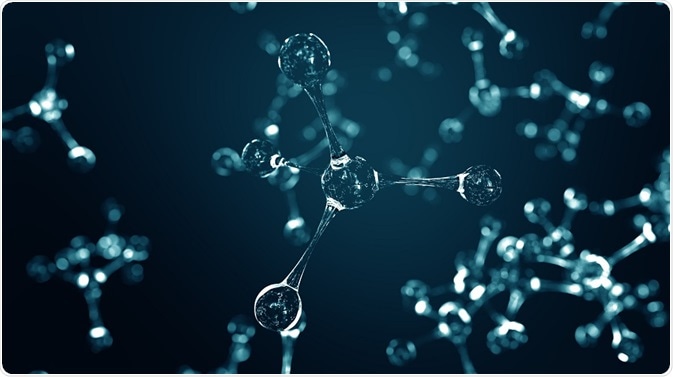
Small Molecules: How They Work
Finding the Mechanism of Action
The mechanism of action (MOA) of a drug is a specific mode of interaction with the body, on a biochemical basis, which leads to the pharmacological effects of the drug.
Credit Novikov Aleksewy | Shutterstock
The teams engaged in drug discovery use high-throughput screening (HTS) in order to test large molecular libraries so that they can separate those which have the MOA they are looking for. This is determined by exposing the molecules to several physiological process components such as ion channels, transporters, enzymes and receptors. These are the sites at which small molecules typically interact.
Actions of Small Molecules
The most common mechanism of action is via receptors, on the surface of the cell, its nucleus or in the cytoplasm. A receptor is a macromolecule which is responsible for activating chemical signals between or inside a cell. The molecule that binds to a receptor is called a ligand. Ligands interact with receptors in many ways:
- Full agonist, when it binds to the receptor with high affinity and full effectiveness, resulting in the highest possible response or maximal effect
- Partial agonist when it binds to the receptor at high affinity but partial effectiveness, producing a response that is short of maximum (submaximal effect), even if the small molecule concentration is high enough for all receptors to be occupied by the ligand
- Inverse agonist is a ligand that binds with high affinity but negative effectiveness, resulting in an effect that is the opposite of that produced by the binding of the full agonist
- Antagonist is a ligand that prevents any action as a result of binding at the receptor
How a small molecule affects any receptor depends on its affinity and efficacy, as is clear from the definitions above. These properties are in turn determined by the chemical structure.
Sometimes a compound consists of two types of molecules which are called enantiomers, that is, they have the same chemical structure but are mirror images of each other. These molecules are also called stereoisomers and are important in that they show differences in their biological activity. Some such molecules show chirality, that is, they are composed of two asymmetric halves which cannot be superimposed, such as glyceraldehyde or the amino acid alanine.
One such chiral drug was used in the 1960s to treat morning sickness in pregnant women. It resulted in a huge outbreak of miscarriages as well as severe congenital deformities. It was found that one of the enantiomers of this drug was responsible for its effectiveness in nausea while the other one caused teratogenicity. Thus chirality became a very important part of the drug discovery and development process, partly due to this finding.
From 1992 onwards, the US Food and Drug Administration (FDA) has issued guidelines for drug issues specific for chiral molecules, including regulations on manufacturing processes as appropriate, product stability, pharmacokinetic testing and quantitative assessments. It has prescribed that the composition of a chiral drug must be presented before it can be subjected to pharmacological, toxicological or clinical tests.
How Drugs Interact With Receptors
There are several different types of chemical interactions such as:
- Electrostatic, involving ionic and hydrogen bonds as well as Van der Waals forces, which is the most common type
- Hydrophobic as is seen with drugs that dissolve in fats
- Covalent as is seen with some types of drugs at alpha-adrenergic receptors, which is the least common type
- Stereospecific as occurs with over half of existing drugs, which are stereoisomers and interact with this specificity with receptors.
Summary
Drug development teams engaged in discovering hits are required to assess the MOA of small molecules, or to start with a particular MOA of interest and proceed to find a matching molecule. The chirality is always a factor to weigh carefully, and assays must be conducted to make sure the enantiomers have known properties.
Most new drugs which have gained approval are single enantiomers or products without chirality. Small molecules act at the receptor through various methods to either activate or deactivate it.
About SmallMolecules.com
SmallMolecules.com is a product-listing-service website that gives pharmaceutical researchers and academics the ability to browse over 600,000 small molecule products, and easily source them from a variety of manufacturers around the world.
The website allows users to search for products by: CAS#, product name, trivial name, alternative name, catalog number, or chemical formula. Once a user has found their required small molecule product, they can simply click-through to the manufacturer’s website and purchase the product directly from the manufacturer.
The mission of SmallMolecules.com is to make the process of sourcing small molecules as simple and efficient as possible for scientists engaged in life sciences research the world over.
Sponsored Content Policy: News-Medical.net publishes articles and related content that may be derived from sources where we have existing commercial relationships, provided such content adds value to the core editorial ethos of News-Medical.Net which is to educate and inform site visitors interested in medical research, science, medical devices and treatments.
Last updated: Sep 27, 2018 at 1:26 PM
























.png)











No hay comentarios:
Publicar un comentario